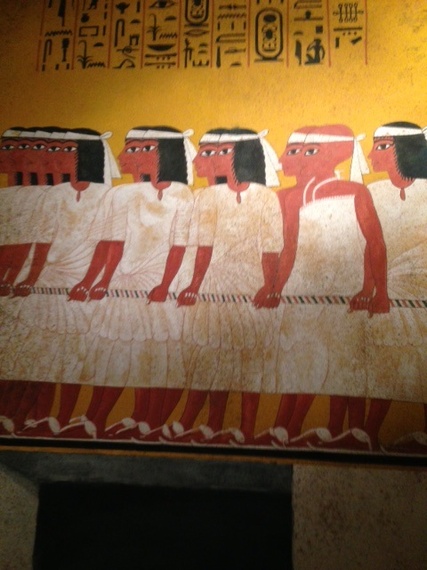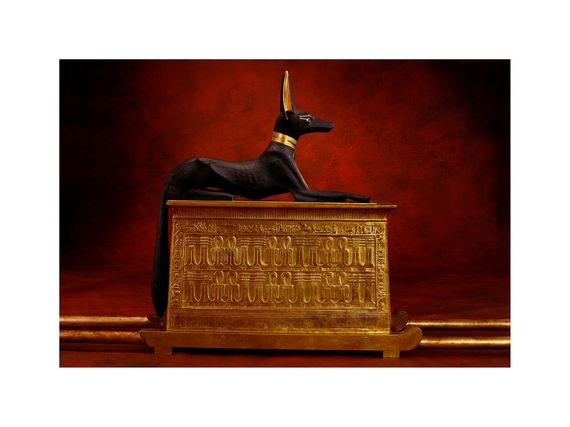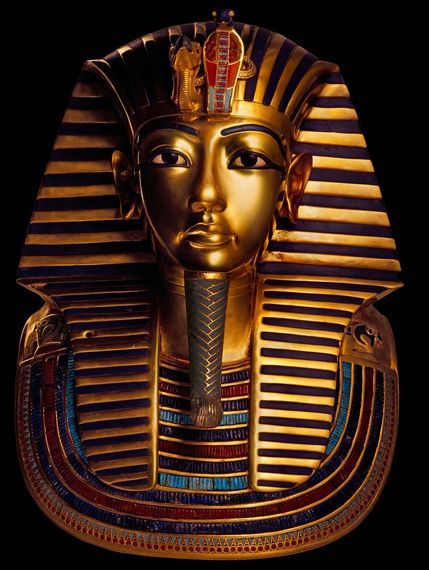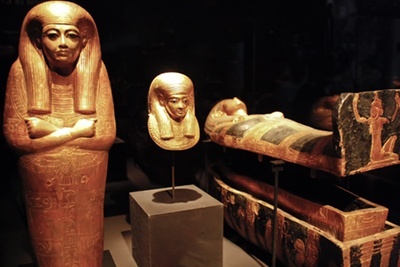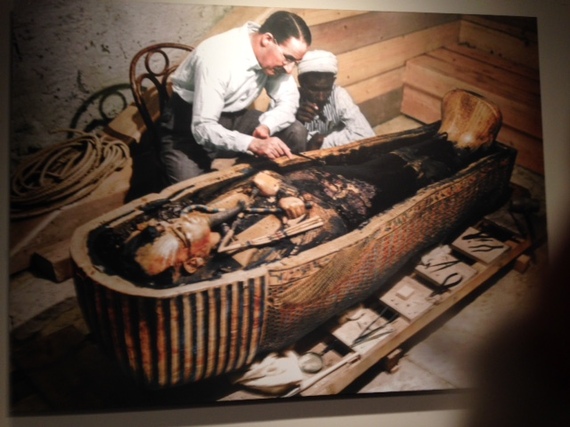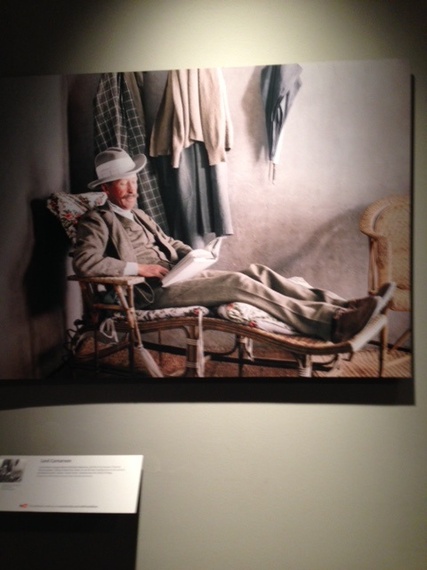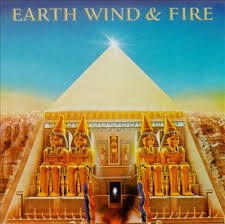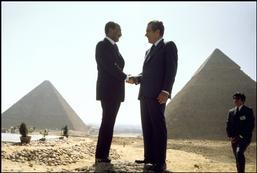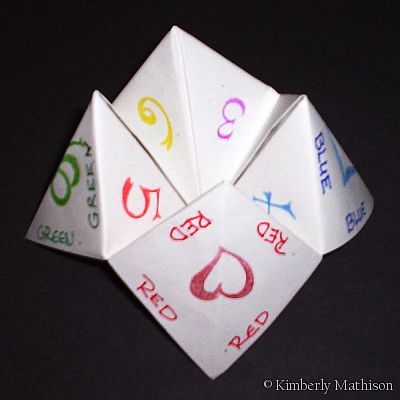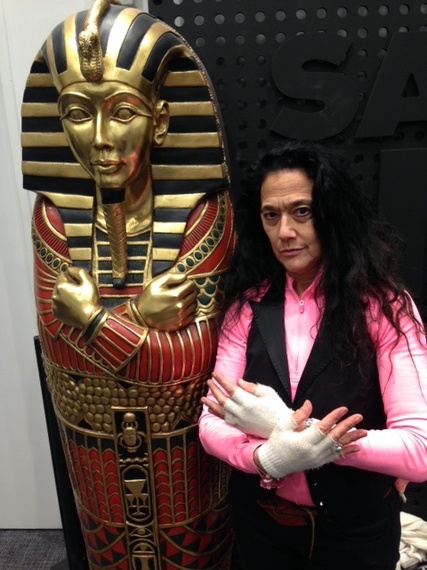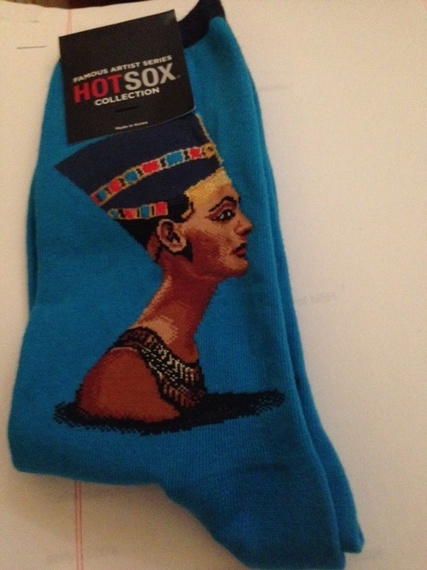There's the ever-impatient saying, TUT TUT; the oh-so-delectable TUT-TI FRUTTI; the musical term TUTTI; the merry Olde English folk game TUT ball, precursor of our national pastime. And then of course there's our old pal King TUT.
Tired of red carpets, awards shows, insulting debates, boring Town Halls, and droning political pundits? Check out the newest incarnation of the Egyptian boy wonder at The Discovery of King Tut exhibit (www.tutnyc.com). Well, maybe he's not so new.
Ok, so I don't know much about history ... and sure don't know much about Egyptology. But lately I've learned a thing or two about the famous boy pharaoh of the 18th Dynasty, who ruled from 1332BC - 1323BC, roughly 30 centuries ago. Who can think back to yesterday, much less 3,000 years ago? All I remember from school trips to the Museum of Natural History was this:
Egypt is filled with pyramids and feisty pharaohs. And oh yes, teen-age rulers. After all, Cleopatra was a mere adolescent when she took the throne. Her brother Ptolemy XIII was 11. Guess England copy-catted with Mary (Queen of Scots) Stuart, a sweet 16-year old ruler. And Tutankhamun was only 19 when he reached his untimely death.
But those Egyptians sure might have taught our current politicians a thing or two about poise, patience, and penmanship. After all, the art of reading, writing, and hieroglyph-ing took tremendous talent...and time. They might have influenced today's teens to stop texting and use some face-to-face time. More tongue-ing, less thumbing. They could have taught our political leaders to stop whining, quit memorizing mantras, and start revering priceless things like the stars, moon and sun...
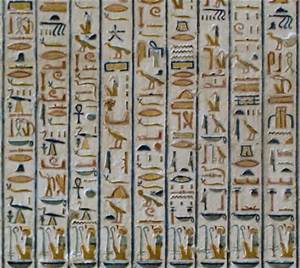
Hieroglyphs. Tomb of Ramses 6 Valley of Kings
www.icias.com
Okay, so I do remember a few details. Tutankhamun was an Egyptian pharaoh of the 18th dynasty, during the period of Egyptian history known as the New Kingdom. His tomb was discovered in the Valley of Kings. He is colloquially referred to as King Tut.
Tut. Sounds simple. One syllable. Tut-ally symmetrical. And inspirational. After all, in the literary classic Winnie the Pooh, Christopher Robin clucked, "Tut tut it looks like rain." And our old friend Dr. Seuss uses it in Horton Hatches an Egg in imploring an elephant to temporarily sit on a nest so Mayzie can get a break:
"Tut, tut," answered Mayzie. "I know you're not small
But I'm sure you can do it. No trouble at all.
Just sit on it softly. You're gentle and kind.
Come, be a good fellow. I know you won't mind."
But way before all that literary, there was King TUT.
Recently there's been a lot of hooplah over a possible discovery that might place Queen Nefertiti in the tomb with the King. I've checked out Dr. Nicholas Reeves' hypotheses and Dr. Zahi Hawass' scientific mummy project, CT scans and all. But after wading through scads of statistics gleaned from historians, librarians, Egyptologists, archaeologists, philologists, gemologists, and meteorologists...and finally, the fascinating "first replica" exhibit: The Discovery of King Tut, at midtown Manhattan's Premier Exhibitions space, I've come up with this most profound statement, so listen up:
What's definite is that nothing is definite.
Look, I went to an Ivy League school, but even my rather curious, questioning brain can't fathom all the 411 about Tut and the discovery of his sealed tomb. Who knew that it takes 70 days to mummify? Or that there are over 1,000 artifacts in the current (Discovery of King) Tut-o-sphere. In today's lingo, I'd say it's huge.
Yup. There's everything in this first Tut replica exhibit from the mummy's golden fingertips to gilded cedar shrines, chariots to castanets, ebony thrones to leopard skinned stools, falcons to fetuses.
It's all about rituals, from reincarnation to worship of Sun God Ra and Osiris, god of resurrection. The tomb (miraculously preserved for 3,000 years) contained shrines of solid gold, weighing over 200 pounds, decorated with divine cobras to protect the contents. And then of course, the Pièce de Resistance: the 24-pound gold and lapis lazuli mask protecting King Tut's head.
Check out Tut's gilded coffins, housed snugly inside each other, nesting-doll style (think Russian porcelain dolls within dolls)  , then lowered into a heavy, rectangular sarcophagus of red granite and yellow quartzite. Let's not forget the corners, adorned with relief carvings of protective goddesses Isis, Nepthet, Selket, and Neit.
, then lowered into a heavy, rectangular sarcophagus of red granite and yellow quartzite. Let's not forget the corners, adorned with relief carvings of protective goddesses Isis, Nepthet, Selket, and Neit.
Nested fetus coffins
Dig It! Carter, the Cairo-practor
Here's what we've got: one young Tut kid king rivaling boy wonder Michael Jackson; one persistent archaeology buff named Howard Carter (sort of a 1920's starving artist), obsessed with the pursuit of King Tut's tomb until the ultimate discovery in November, 1922; one long hot trek from the excavation digging site to Cairo; one race car nut-turned-philanthropist -- George Herbert, the 5th Earl of Carnarvon (think George Soros or Bill Gates) who, after a racing car accident traveled to Egypt, met Carter, and became his sole benefactor, financing the excavation in Thebes -- until the funds ran out. Enter Harry Burton, one eager archivist/photographer, and we've got ourselves a Tut-A-team!
The Drama of Tut-O-Rama
Yup. We've got ourselves one pop culture phenomenon of Egypt-o-mania, from the striped headdress to the gold leaf coated replica of Selket, the goddess who guarded the shrine containing the pharaoh's organs; one semi-cult of Tut-maniacs intrigued by the rituals, the reverence, the razzma-TUT-tazz of it all.
Tut-mania started in the late 70's in the states and peaked in 1978 at NYC's Metropolitan Museum, the last stop of the epic Treasures of Tutankhamun six-city American tour. (That exhibit contained 55 real objects from Tut's tomb, straight from the Museum of Cairo). The line of "Tut-maniacs" extended from the museum's entrance on 82nd Street down 5th Avenue to 59th street. Paparazzi shadowed the celebs who attended, including Liz Taylor, Robert Redford, Nancy Reagan, and Andy Warhol, Patty Hearst (shortly before she was whisked off to jail) and Cher.
Comedian Steve Martin did a memorable King Tut routine with original lyrics like How'd you get so funky? Even hip-hop dance took up the cause with Tutting (a style of popping your hands and arms at right angles in sync to the beat) that originated from the choreography of 1970's funk band King Boogaloo Tut.
Iconic 70's band Earth Wind & Fire 's peak coincided with the American Tut tour, and their record album covers for I Am and All 'n All were inspired by Egyptian Tut-esque themes. And for mystery and intrigue, Rapper NAS had a major mishap when the designers used a clay mold to replicate Tut's golden mask for his own album art. Some residue of clay mistakenly got stuck in his nostril, blocking his breathing momentarily.
Tut: from Watergate to Bloomingdale's
On his last overseas trip to Egypt (1974), former President Richard Nixon befriended President Anwar Sadat. The White House administration helped divert the focus off of Watergate with the signing of an agreement to allow the King Tut treasures to travel to America. Wa-Tut-ergate?
In Golden 20's Hollywood, Charlie Chaplin, Mary Pickford and Douglas Fairbanks attended an elaborate exhibit created for movie theater mogul Sidney Grauman's Egyptian Theater, a gaudily romanticized tribute to Egyptian art and architrave, with stones, scarabs, pillars, and sphinx heads. In the 1970's, Bloomingdale's touted a line of Tut-inspired linens, home decor, and accessories, with I  ❤ New York spelled out in hieroglyphics. Margaux Hemingway wore a hieroglyph-imprinted dress to a celebrity wedding in Beverly Hills. More recently, Spike TV broadcast Tut, the mini-series, starring Ben Kingsley.
Pharaoh Photo Finish
Harry Burton, a photographer on loan from the Metropolitan Museum, brought Carter's discoveries in the Valley of Kings to life, vividly documenting the archaeologist's excavation. He was there with "Team Tutankhamun" when Carter first entered the tomb with his infamous candle and glimpsed "everywhere, the glint of gold." Images of jewels, artifacts, and figurines popped up, as well as headlines about "TUT-ANKH-AMEN." Sounds like a rather exotic end of a prayer, don't you think?
Just when you thought you'd be way too weary to wander through corridors of tombs, chambers and mummified beings, Surprise! It's none other than Museum Hack, created to assist those of us who squint and crawl our way through dark museum exhibits, getting cranky and seeing red.
Back on Track with Mark Lach & Museum Hack
Bopping along the Discovery trail, I found the mesmerizing Tut exhibit -- skillfully designed by Rainer Verbizh -- filled with eye-popping trivia, life-size tombs and masterfully reproduced memorabilia, down to the precious detail of Tut's grandma's lock of hair. I glided through, listening to a most inspiring and synchronistic audio tape, presented by the gracious guides at the start of the two-floor loop. Kudos to both Verbizh and Mark Lach, Creative Director, Premier Exhibitions (which includes the charming Saturday Night Live exhibit), for an artful blend of the space's whimsy and wonder. Alas, even the most passionate and eager sphinx wanna-bees amongst us get a tad weary.
I joined an otherwise bleary-eyed tour group, and yes, I was stunned. The kids were wide-eyed. Museum Hack (www.museumhack.com) is a genius concept to make museums fun. Their philosophy? "People are people," regardless of what century. Their special formula to fight museum fatigue is "subversive and non-traditional." They've conquered the unconquerable -- what no other parent, teacher or guide has managed to do. Museum Hack puts an end to boring tours, endless exhibition dioramas, plaques and verbiage. Museum Hack performs "MUMMY RAP" lyrics about Tut and his tomb, bringing dust and death back to life. They make ancient history scintillating, describing identifiable stuff, from make-up to mistakes.
Museum Hack is reverently irreverent. Team members toss out fun facts, much easier to absorb than abstract theories. I for one learned that coal and malachite, used for make-up, were alkaloids, which prevented infections from the Nile river floods. Museum Hack translated the famous "curse," a string of bad luck in the archaeological dig, into "bad things happen to dig people." Bex, Harry and Evan used that famous children's origami paper fortuneteller game to link each tour group member to one of the King Tut characters.
They also gave us the dirt on the famous King Tut mask. Apparently workers handling the delicate artifact accidentally knocked off the long braided beard, then glued it back on rather sloppily. Just can't get quality labor these days. How'd we ever get those pyramids built?!
BFF's Kim, Chloe & Cleopatra
Nope, there was no tv or Keeping up with the Kardashians, but cheek and lip color were a must for the Egyptians, just like today's 21st century teenagers and millennials. The colorful green eye paint and black kohl appeal to all ages. Museum Hack passes around the malachite, so we can touch and feel the sparkly green stone used for cosmetics. Their m.o.? Bring the obscure back to reality with tidbits about family, friends and eyeliner.
O.C.D. - Obstinate Compelled & Determined aka Obsessive Collector & Discoverer
Indeed, Howard Carter was obsessive about his search. He started at age 17 and King Tut died at 19. Perhaps he identified with his intriguing subject's age. He rose to become Chief Inspector of Antiquities for Upper Egypt but his career was cut to the quick. Against all odds (lack of funds and intensive heat), he persevered. Despite a slew of bizarre mishaps (a cobra killed his canary, for one) and superstitious signs of negativity, he pressed on.
Mortality & Spirituality
These young Egyptian royals and their peeps didn't seem to search endlessly for the meaning of life. They weren't desperate to find a guru, a yoga group or a Zen monastery. They already had their spiritual mentors like Aten, the sun God, and Ka, the spirit force of the deceased. The funerary culture was essential to sustain KT, the eternal spirit. Amongst the burial rituals, the Egyptians used red jasper amulets to guarantee smooth sailing into the afterlife, protected by Isis, mother-goddess of magic, wisdom, and life. Falcon plumage ensured cosmic protection in the form of the avian sky god Horus.
A Gory Story of Glory
Let's face it. Morbid makes an impact. The Discovery of King Tut teaches us that poor boy Tut might have met an untimely, rather unpleasant, violent end. 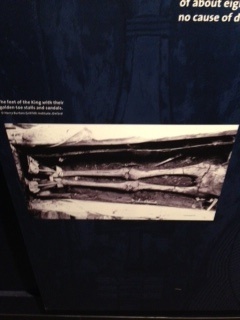
King Tut's skeleton (replica), The Discovery of King Tut
Splinters were found in his skull which might indicate a treacherous attack, along with a knee injury and possible malaria infection. Routine mummification included the use of resin, removal of his entrails--cut from the navel to the left thigh--and an empty skull. Some of Tut's vital organs are contained in "coffinettes" in the tomb, which makes The Addams Family look like The Sound of Music.
Far, Phar-aoh Ahead of Their Time
3,000 years ago the Egyptians seemed more advanced than today's scientific experts. They could have been professors, nutritionists, pharmacologists or micro-biologists. Just ask Dr. David P. Silverman, curator of the original Treasures of Tutankhamun and University of Pennsylvania Curator-in-Charge of the Egyptian Collection. According to Dr. and Professor Silverman, the medical texts describe some pretty sophisticated stuff. They indicate a knowledge of holistic as well as scientific methods of treating symptoms. No doctors' prescription pads, I imagine. But "they used honey -- a good source of keeping away infections...they ate days' old bread, which we associate with mold...(it's) practically penicillin...and they knew about contraceptives."
As for career options? They could have chosen cosmetology or dermatology. There was no SPF # in Egyptian suntan lotion, as far as I know. But the soot in kohl helped prevent damaging effects of sun glare on their eyes. Way ahead of Revlon or L'Oreal, the Egyptians were savvy in skincare, creating a remedy for burns by mixing mixed cheek and lip stain; and improving skin with red natron, northern salt and honey. No wonder the medical world took the name Mt. Sinai -- the sacred Egyptian site -- as one of the most prominent hospitals in New York City.
Riddle of the Sphinx - What's Certain is Uncertain
Furthermore, as Dr. Silverman explains, the Egyptians considered the healing effects of foods, minerals and cosmetics as much magical as medical. So who said science was exact?
Ok, dare I say it? Professor Silverman, in his massive wisdom of the World of Tut, seems a reincarnation of the sphinx itself. Like the fluidity of the Nile, he states that "everything in Egyptology changes." Theories rise and set like the sun. Even after the 2010 DNA analysis of the two mummified stillborn children, it's definite that there are no definites. They may, or may not, be related. They may, or may not, be his daughters. One of two older female mummies may, or may not, be Queen Nefertiti. And, to make things more complex, Nefertiti may have changed gender and become King for a short while, under another name. Trans-gender roles were common; in one theory, she was the obscure pharaoh Smenkhkare, and may have ruled with Akhenaten in traditional royal male clothing. Once again, ahead of their Tut-ankhamen time.
Sarcophagi & Stylists - Fashion Week at the Nile
Fast forward to February 2016, and perhaps these Egyptians could have been consultants for Fashion Week, considering their intricate designs, patterns, stripes, and use of color...and of course, their sophistication with cosmetics. Beauty was a sign of holiness. Face, cheek and lip makeup used the red ochre from clay washed and dried in the sun. Henna, a naturally occurring plant, was used by the ancient Egyptians to paint their nails, and dye their hair.
Tom Ford? Valentino? Vintage Chanel? Hotsox? Nefertiti has been discovered to have worn men's clothing -- way ahead of George Sand, Gertrude Stein and Diane (Annie Hall) Keaton.
Manolo Blahnik, eat your heart out. The golden sandals that adorned the royalty's feet were elegant...and I don't really think Queen Nefertiti had much need for 6" heels.

